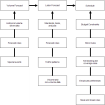Forecasting provides you with an objective and focused means to predict future labor requirements. Using rules, business drivers, and special events that you set up, as well as actual volume and other business data from previous weeks and years, it forecasts business volume and labor requirements for future date ranges at a daily level.
Forecasting has the following work spaces:
- Using the Forecast Planner you can view and modify the volume forecasts and labor forecasts that the scheduler uses to create a schedule.
- From historical volume driver data, the Forecast Planner derives a traffic pattern. Then, applying your labor standards to volume driver data and other factors, the Forecast Planner generates a labor forecast in 15-minute intervals, one week at a time.
- The system makes the labor forecast available to the Schedule Generator, which looks at individual employees and schedule rules to create a 15-minute interval schedule, one week at a time, for each selected location.
- Using the Operational Dashboard you can monitor the performance of your forecast and its impact on labor. Because the Operational Dashboard is fully integrated with Forecast Planner and KPI Builder, you can configure it to display many types of business data related to volume and labor. See the The Operational Dashboard topic.
- A graphical view is available in Forecast Home.
The system uses the data and the elements you configure to generate the volume forecast, the labor forecast, and the schedule. You can import volume and labor forecasts to easily examine and analyze their performance and accuracy comparing actual and forecasted values.
The volume forecast is a prediction of how much business is going to be done at a future date, and volume drivers are the source of the volume forecast. The volume forecast is an input to the labor forecast.
The Forecast Planner predicts weekly business volumes by day of the week based on the following:
- Large samples of historical, actual volume data
- Configured forecast rules
- Adjustments to the predicted volumes for special events such as promotions and holidays
For more information, see the following:
- The Volume Forecast
- The Volume Workspace
- The concepts and methods of generating a volume forecast are provided in .
The labor forecast is a prediction of how many employees are required, per job, to fulfill the projected amount of business in the volume forecast. The labor forecast is an input to the Schedule Engine.
The Forecast Planner predicts daily labor requirements based on the following:
- The volume forecast
- Labor standards assigned to tasks and task groups
- Configured forecast rules
- Traffic patterns
- Non-business drivers: static drivers, custom drivers, and fixed frequency drivers
- Hours of operation
For more information, see the following:
Forecast Home shows a graphical view of the Volume data. It shows weekly volume in a bar graph for a single location. The graph is read-only and you cannot edit the volume.
See the Forecast Home topic.
